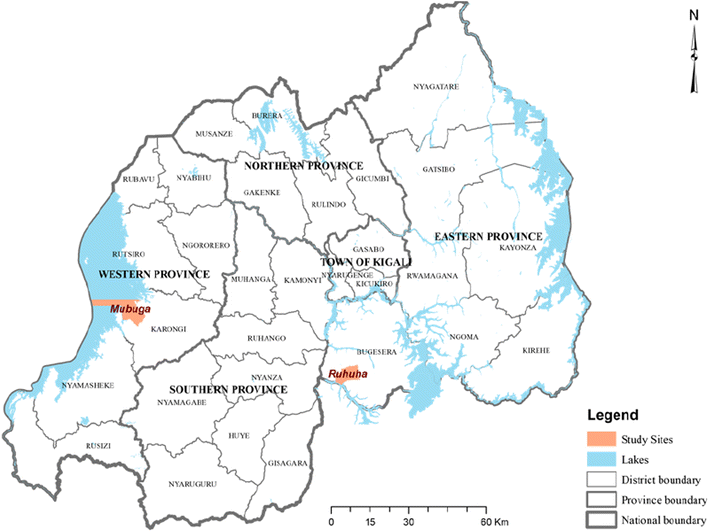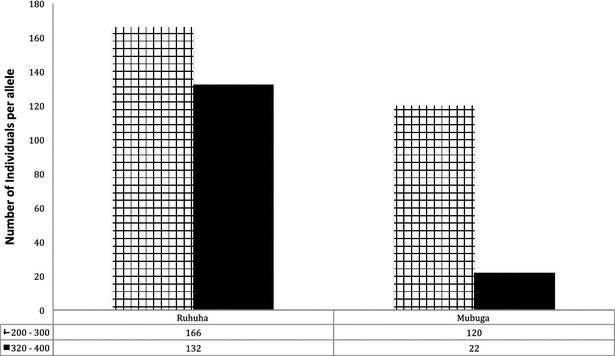Malaria case clinical profiles and Plasmodium falciparum parasite genetic diversity: a cross sectional survey at two sites of different malaria transmission intensities in Rwanda
- PMID: 27113354
- PMCID: PMC4845397
- DOI: 10.1186/s12936-016-1287-5
Malaria case clinical profiles and Plasmodium falciparum parasite genetic diversity: a cross sectional survey at two sites of different malaria transmission intensities in Rwanda
Abstract
Background: Malaria remains a public health challenge in sub-Saharan Africa with Plasmodium falciparum being the principal cause of malaria disease morbidity and mortality. Plasmodium falciparum virulence is attributed, in part, to its population-level genetic diversity-a characteristic that has yet to be studied in Rwanda. Characterizing P. falciparum molecular epidemiology in an area is needed for a better understand of malaria transmission and to inform choice of malaria control strategies.
Methods: In this health-facility based survey, malaria case clinical profiles and parasite densities as well as parasite genetic diversity were compared among P. falciparum-infected patients identified at two sites of different malaria transmission intensities in Rwanda. Data on demographics and clinical features and finger-prick blood samples for microscopy and parasite genotyping were collected(.) Nested PCR was used to genotype msp-2 alleles of FC27 and 3D7.
Results: Patients' variables of age group, sex, fever (both by patient report and by measured tympanic temperatures), parasite density, and bed net use were found differentially distributed between the higher endemic (Ruhuha) and lower endemic (Mubuga) sites. Overall multiplicity of P. falciparum infection (MOI) was 1.73 but with mean MOI found to vary significantly between 2.13 at Ruhuha and 1.29 at Mubuga (p < 0.0001). At Ruhuha, expected heterozygosity (EH) for FC27 and 3D7 alleles were 0.62 and 0.49, respectively, whilst at Mubuga, EH for FC27 and 3D7 were 0.26 and 0.28, respectively.
Conclusions: In this study, a higher geometrical mean parasite counts, more polyclonal infections, higher MOI, and higher allelic frequency were observed at the higher malaria-endemic (Ruhuha) compared to the lower malaria-endemic (Mubuga) area. These differences in malaria risk and MOI should be considered when choosing setting-specific malaria control strategies, assessing p. falciparum associated parameters such as drug resistance, immunity and impact of used interventions, and in proper interpretation of malaria vaccine studies.
Keywords: Malaria; Multiplicity of infection; Parasite density; Plasmodium falciparum; Rwanda.
Figures



Similar articles
-
Genetic diversity and allele frequencies of Plasmodium falciparum msp1 and msp2 in parasite isolates from Bioko Island, Equatorial Guinea.Malar J. 2018 Dec 7;17(1):458. doi: 10.1186/s12936-018-2611-z. Malar J. 2018. PMID: 30526609 Free PMC article.
-
Genetic diversity of Plasmodium falciparum isolates from concurrent malaria and arbovirus co-infections in Kedougou, southeastern Senegal.Malar J. 2016 Mar 11;15:155. doi: 10.1186/s12936-016-1208-7. Malar J. 2016. PMID: 26969623 Free PMC article.
-
Plasmodium falciparum msp1 and msp2 genetic diversity and allele frequencies in parasites isolated from symptomatic malaria patients in Bobo-Dioulasso, Burkina Faso.Parasit Vectors. 2018 May 30;11(1):323. doi: 10.1186/s13071-018-2895-4. Parasit Vectors. 2018. PMID: 29843783 Free PMC article.
-
Plasmodium falciparum genetic diversity and multiplicity of infection based on msp-1, msp-2, glurp and microsatellite genetic markers in sub-Saharan Africa: a systematic review and meta-analysis.Malar J. 2024 Apr 8;23(1):97. doi: 10.1186/s12936-024-04925-y. Malar J. 2024. PMID: 38589874 Free PMC article.
-
Multiplicity of Asymptomatic Plasmodium falciparum Infections and Risk of Clinical Malaria: A Systematic Review and Pooled Analysis of Individual Participant Data.J Infect Dis. 2020 Feb 18;221(5):775-785. doi: 10.1093/infdis/jiz510. J Infect Dis. 2020. PMID: 31585009 Free PMC article.
Cited by
-
Assessment of submicroscopic infections and gametocyte carriage of Plasmodium falciparum during peak malaria transmission season in a community-based cross-sectional survey in western Kenya, 2012.Malar J. 2016 Aug 19;15(1):421. doi: 10.1186/s12936-016-1482-4. Malar J. 2016. PMID: 27543112 Free PMC article.
-
Pfhrp2-Deleted Plasmodium falciparum Parasites in the Democratic Republic of the Congo: A National Cross-sectional Survey.J Infect Dis. 2017 Jul 1;216(1):36-44. doi: 10.1093/infdis/jiw538. J Infect Dis. 2017. PMID: 28177502 Free PMC article.
-
Molecular approaches to determine the multiplicity of Plasmodium infections.Malar J. 2018 Apr 23;17(1):172. doi: 10.1186/s12936-018-2322-5. Malar J. 2018. PMID: 29685152 Free PMC article. Review.
-
Prevalence and associated factors of malaria among febrile patients at two sites with different transmission intensities, Northwest Ethiopia.Parasite Epidemiol Control. 2025 Jun 16;30:e00441. doi: 10.1016/j.parepi.2025.e00441. eCollection 2025 Aug. Parasite Epidemiol Control. 2025. PMID: 40607278 Free PMC article.
-
Prevalence of antimalaria drug resistance-conferring mutations associated with sulphadoxine-pyrimethamineine-resistant Plasmodium falciparum in East Africa: a systematic review and meta-analysis.Ann Clin Microbiol Antimicrob. 2025 Apr 16;24(1):25. doi: 10.1186/s12941-025-00795-7. Ann Clin Microbiol Antimicrob. 2025. PMID: 40241183 Free PMC article.
References
-
- WHO. World Malaria Report 2014. Geneva: World Health Organization; 2014. http://www.who.int/malaria/publications/world_malaria_report_2014/wmr-20.... Accessed 12 May 2015.
-
- USAID. Presidential Malaria Initiative—Rwanda, Malaria Operational Plan FY 2015. 2015. http://www.pmi.gov/docs/default-source/default-document-library/malaria-.... Accessed 13 Jan 2016.
Publication types
MeSH terms
Substances
Grants and funding
LinkOut - more resources
Full Text Sources
Other Literature Sources
Research Materials

